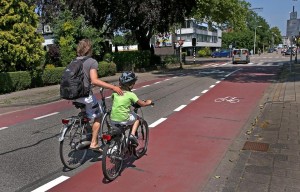A September 22, 2013 article in the Boston Globe on the state of bicycling in the Netherlands has lessons I think could be applied to the Squannacook River Rail Trail.
The Netherlands today is a country where bicycles and cars co-exist with far fewer problems than here in the US. The Globe article makes the point that this was not always the case – back in 1967, the chief of traffic policy noted that bicycling in Amsterdam was “tantamount to attempting suicide.”
The Dutch took two major steps to change this. First, they started to design bicycling infrastructure that separated bicyclists from cars. Unlike the bike lanes you might see in Boston, where bicyclists ride between the moving traffic and parked cars, in the Netherlands bike lanes are almost always next to the sidewalk. Often the bicycle lanes are physically separated from the road by barriers. The Dutch take great effort to ensure their infrastructure works for automobiles, bicyclists, and pedestrians together.
The second step they took is one that I believe is equally important – they incorporated bicycling education into their standard curriculum in school. Every child in the Netherlands learns at a young age to comfortably and safely ride in traffic.
So what is the result of this two-pronged approach? If you look at the pictures of who is riding bicycles in the Netherlands, its everybody! Its children riding to school, its retired folks doing errands, and its business people going to work. Most people are riding at a gentle pace wearing just their regular clothes. In the Netherlands, people ride bikes to do about 35% of their chores.
So what can our group, Squannacook Greenways, learn from the Dutch as we go about building the Squannacook River Rail Trail? As a rail trail, we are naturally separated from the road. But the Squannacook River Rail Trail is not just for recreation – since it parallels the bicycle-unfriendly Route 119 and Townsend Road in Groton, it serves very much as a transportation option for bicyclists and pedestrians in Townsend and Groton.
But I think the more important lesson we can learn from the Dutch is the importance of bicycle education. If we want young people to be able to bike from their homes to destinations in our area safely using the Squannacook River Rail Trail, we need to make sure they know the rules of the road as they bike to and from the rail trail. We have all seen young people riding their bicycles opposite to traffic, in the mistaken belief that if they can see on-coming traffic, they will be safer. With bicycle education they would learn that most accidents with bicycles involve turning cars, and riding opposite to traffic greatly increases the odds of a turning car not seeing a bicycle.
That is why Squannacook Greenways included in our last successful grant proposal to the Community Foundation of North Central Massachusetts a commitment to bringing bicycle education to our local schools as part of the opening of our trail. If we want to make Townsend and Groton truly bicycle-friendly towns, we need both great facilities and educated users, and we as a non-profit are committed to developing both.
